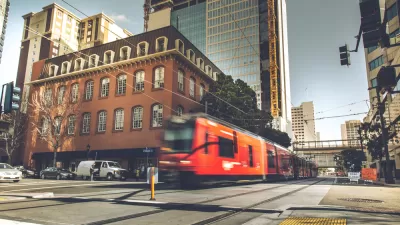A common criticism of streetcars are their relative slow speed combined with high capital and operating costs. Still, streetcars are being constructed in both large in small cities to help incentivize development.
Streetcars run at street-level, therefore, running directly along with the flow of traffic, and even stopping at stoplights. As Mary Newsom of The Naked City describes, many critics of streetcars "seem to be assessing the streetcar's value by whether it's faster than driving...," and as in one Charlotte Observal editorial writes, the streetcar "would operate on regular streets, stopping for red lights and traffic congestion. It wouldn't be faster than a bus. It would merely be a very expensive, but very pretty, bus. What the city is buying is an aesthetic."
Instead, as Newsom argues, is the true success of the streetcar, and why so many cities, big and small, around the U.S. are building high-priced, short-length routes; the streetcar provides a powerful incentive to development. She argues, "lost in that analysis, and in remarks by some that a streetcar is just a toy, is this: Development reacts to streetcars very differently from the way it reacts to bus routes." So even while the streetcar may not effectively increase speeds for those who switch to it over driving or using the bus, the gains from new development outweigh the transportation issues the streetcar fails to solve.
But yet, is it still worth it? Newsom cites, indeed, the millions of dollars cities and counties spend in other development incentives, such as building sports stadiums. What types of investments, as well as what kinds of funding mechanisms for such large projects, will certainly need to be the source for more research in the future.
FULL STORY: Is a streetcar speedy? And other red herrings

Planetizen Federal Action Tracker
A weekly monitor of how Trump’s orders and actions are impacting planners and planning in America.

Maui's Vacation Rental Debate Turns Ugly
Verbal attacks, misinformation campaigns and fistfights plague a high-stakes debate to convert thousands of vacation rentals into long-term housing.

San Francisco Suspends Traffic Calming Amidst Record Deaths
Citing “a challenging fiscal landscape,” the city will cease the program on the heels of 42 traffic deaths, including 24 pedestrians.

Defunct Pittsburgh Power Plant to Become Residential Tower
A decommissioned steam heat plant will be redeveloped into almost 100 affordable housing units.

Trump Prompts Restructuring of Transportation Research Board in “Unprecedented Overreach”
The TRB has eliminated more than half of its committees including those focused on climate, equity, and cities.

Amtrak Rolls Out New Orleans to Alabama “Mardi Gras” Train
The new service will operate morning and evening departures between Mobile and New Orleans.
Urban Design for Planners 1: Software Tools
This six-course series explores essential urban design concepts using open source software and equips planners with the tools they need to participate fully in the urban design process.
Planning for Universal Design
Learn the tools for implementing Universal Design in planning regulations.
Heyer Gruel & Associates PA
JM Goldson LLC
Custer County Colorado
City of Camden Redevelopment Agency
City of Astoria
Transportation Research & Education Center (TREC) at Portland State University
Jefferson Parish Government
Camden Redevelopment Agency
City of Claremont





























